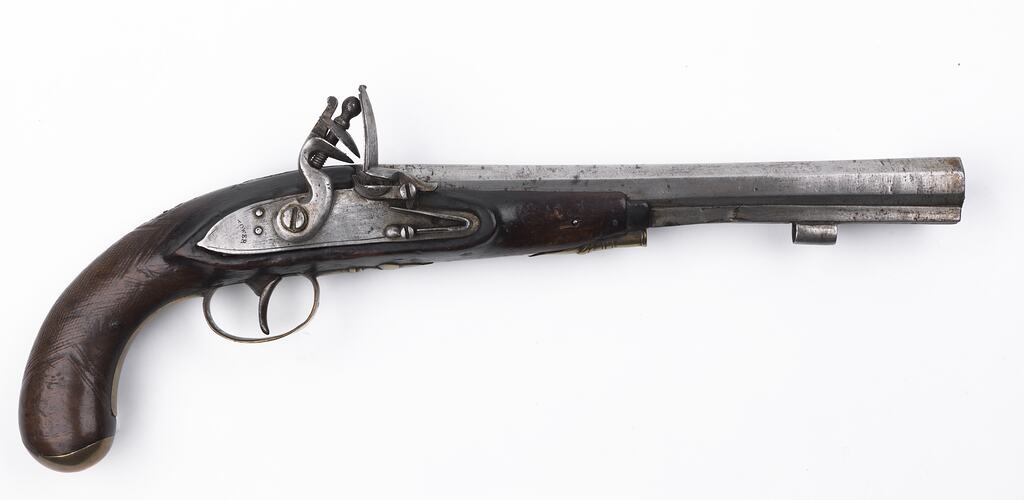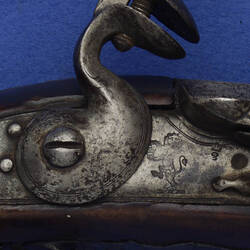Summary
Flintlock pistol, cal. 22 bore (.590 inch). British stock with an incorrect barrel fitted, probably in India.
One of a collection of weapons seized from mutineers during the Indian Mutiny (1857-1859), and subsequently donated to the Melbourne Public Library in 1860 by Earl Charles Canning, Governor-General of India.
Physical Description
Muzzle loading, smooth bore octagon barrel 9 7/8 inch (251 mm.) long. Side lock & hammer, oval brass trigger guard with acorn extension, wooden stock extends halfway to muzzle, brass butt cap.
Significance
This is one of 287 weapons and associated items from the Indian Mutiny (1857-1859), donated to the Melbourne Public Library in 1860 by Earl Charles Canning, Governor-General of India. The weapons had been seized from the Indian mutineers by British troops during the course of the mutiny.
The donation was in response to a suggestion by Redmond Barry, Chairman of Trustees, that a letter be sent to Sir Henry Barkly, Governor of Victoria, requesting him to write to the Governor-General of India. The letter to Barkly, dated 9 May 1859, noted that 'such objects placed in the Museum attached to the Library would afford interesting illustration of oriental national customs and peculiarities.'
The weapons were also war booty, signifying the relief of Victorians that their fellow colonists in India were once more safe. Many Victorian colonists (including Barry) had relatives in the British army and administration in India, had anxiously followed the bulletins of the Indian Mutiny in the newspapers, and raised funds locally to aid the cause. Some of the weapons were displayed in the main stairwell of the Library, alongside Australian Aboriginal weapons. Here they became symbols of the defeat of local peoples as the British Empire expanded around the globe.
The collection was subsequently transferred to the National Gallery of Victoria, and thence in parts to the Industrial & Technological Museum during the early decades of the twentieth century. At each stage in its history, the collection has been gradually reduced in size through items being presented or disposed of.
More Information
-
Collection Names
-
Collecting Areas
-
Acquisition Information
Donation & Subsequent Transfer from National Gallery of Victoria (NGV), Earl Charles John Canning, 01 Apr 1914
-
Place & Date Made
-
Place & Date Used
-
Collector
Earl Charles John Canning, Calcutta, India, 1860
Canning was Governor General of India, 1856-1862. -
Inscriptions
Stamped on lock "Tower".
-
Classification
-
Category
-
Discipline
-
Type of item
-
Overall Dimensions
400 mm (Width)
-
References
[Book] David, Saul. 2002. The Indian Mutiny, 1857.
[Book] Galbally, Ann & Inglis, Alison. 1992. The First Collections: The Public Library and the National Gallery of Victoria in the 1850s and 1860s.
-
Keywords




